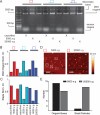Design and Assembly of a Cargo-Agnostic Hollow Two-Lidded DNA Origami Box
- PMID: 40762261
- PMCID: PMC12365872
- DOI: 10.1021/acsabm.5c00907
Design and Assembly of a Cargo-Agnostic Hollow Two-Lidded DNA Origami Box
Abstract
DNA origami, a method of folding DNA into precise nanostructures, has emerged as a powerful tool for the design of complex nanoscale shapes. It has great potential as a technology to encapsulate and release cargos spanning small molecules through large proteins, while remaining stable in a variety of ex vivo processing conditions and in vivo environments. While DNA origami has been utilized for drug delivery applications, the vast majority of these structures have been flexible, flat 2D or solid 3D nanostructures. There is a crucial need for a hollow and completely enclosed design capable of holding and eventually releasing a variety of cargos. In this paper, we present the design and assembly of a hollow DNA origami box with two lids. We characterize the isothermal conditions for structural assembly within minutes. We demonstrate that passive loading of small molecules is charge dependent. We also outline an approach to design staple extensions pointing into the cavity or outside of the hollow DNA origami, allowing for the active loading of protein or the potential for decoration with passivating or targeting molecules.
Keywords: Smart nanomaterials; controlled release; helical twist; isothermal assembly; stability.
Figures







Similar articles
-
Prescription of Controlled Substances: Benefits and Risks.2025 Jul 6. In: StatPearls [Internet]. Treasure Island (FL): StatPearls Publishing; 2025 Jan–. 2025 Jul 6. In: StatPearls [Internet]. Treasure Island (FL): StatPearls Publishing; 2025 Jan–. PMID: 30726003 Free Books & Documents.
-
Analyzing DNA Origami Nanostructure Assembly by Dynamic Light Scattering and Nanoparticle Tracking Analysis.Small Methods. 2025 Aug;9(8):e2500295. doi: 10.1002/smtd.202500295. Epub 2025 Jun 19. Small Methods. 2025. PMID: 40536202 Free PMC article.
-
Nucleic Acid Nanocapsules as a New Platform to Deliver Therapeutic Nucleic Acids for Gene Regulation.Acc Chem Res. 2025 Jul 1;58(13):1951-1962. doi: 10.1021/acs.accounts.5c00126. Epub 2025 Jun 9. Acc Chem Res. 2025. PMID: 40491030
-
Toward Precise Fabrication of Finite-Sized DNA Origami Superstructures.Small Methods. 2025 Jun;9(6):e2401629. doi: 10.1002/smtd.202401629. Epub 2024 Dec 5. Small Methods. 2025. PMID: 39632670 Review.
-
The Black Book of Psychotropic Dosing and Monitoring.Psychopharmacol Bull. 2024 Jul 8;54(3):8-59. Psychopharmacol Bull. 2024. PMID: 38993656 Free PMC article. Review.
References
-
- Lucas C. R., Halley P. D., Chowdury A. A., Harrington B. K., Beaver L., Lapalombella R., Johnson A. J., Hertlein E. K., Phelps M. A., Byrd J. C., Castro C. E.. DNA Origami Nanostructures Elicit Dose-Dependent Immunogenicity and Are Nontoxic up to High Doses In Vivo. Small. 2022;18(26):2108063. doi: 10.1002/smll.202108063. - DOI - PMC - PubMed
-
- Wamhoff E.-C., Knappe G. A., Burds A. A., Du R. R., Neun B. W., Difilippantonio S., Sanders C., Edmondson E. F., Matta J. L., Dobrovolskaia M. A., Bathe M.. Evaluation of Nonmodified Wireframe DNA Origami for Acute Toxicity and Biodistribution in Mice. ACS Appl. Bio Mater. 2023;6(5):1960–1969. doi: 10.1021/acsabm.3c00155. - DOI - PMC - PubMed
MeSH terms
Substances
LinkOut - more resources
Full Text Sources
